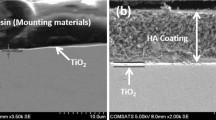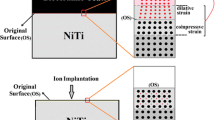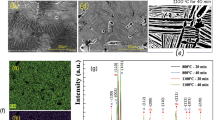Abstract
Nickel-titanium shape memory alloy is a novel material with outstanding properties suitable for biomedical applications such as implantation devices. Unfortunately, the high composition of nickel in this alloy can be harmful to the human body, if its exposure exceeds a threshold value. Therefore, an innovative electrical discharge coating technique was investigated and proposed in this study to develop minimal microdefect formation with high corrosion resistance through fractional factorial design of experiment. The results showed that discharge duration mostly dominated the material deposition, microcracks, and porosity fraction up to 72%, due to the impact of the intensity of discharge energy. There was also a pronounced effect of titanium powder concentration in the deionized water on the percentage of titanium and nickel elements and microcrack formation. The powder suspension enhanced the recast layer formation through the increment of layer density, which covered up the Ni-rich region and diminished the microcrack formation. An optimized substrate recorded the lowest corrosion current, \({\text{I}}_{\text{corr}}\), and highest corrosion voltage, \({\text{E}}_{\text{corr}}\), at 3.43 × \({10}^{-{6}}\) µA/cm2 and − 0.07 V respectively, thus exhibiting an outstanding corrosion resistance rate at only 8.57 µm/year in phosphate-buffered saline solution, due to the low nickel concentration, low microcracks, and low porosity fraction in the recast layer. Therefore, the results obtained within this styud presented an initial step towards assessing the feasibility of applying the electrodischarge process to biomaterials, including nickel-titanium shape memory alloy. Further exploration, involving both in-vitro and/ or in-vivo studies, is essential to thoroughly evaluate the performance of the coating obtained from the process.














Similar content being viewed by others
Data availability
Not applicable.
Code availability
Not applicable.
References
Mansor AF, Jamaluddin R, Azmi AI, Lih TC, Zain MZM (2019) Surface modification of nitinol by using electrical discharge coatings in deionized water. IOP Conf Ser Mater Sci Eng 670(1). https://doi.org/10.1088/1757-899X/670/1/012010
Zhang L et al (2017) Graphene enhanced anti-corrosion and biocompatibility of NiTi alloy. NanoImpact 7:7–14. https://doi.org/10.1016/j.impact.2016.10.003
Prakash C, Kansal HK, Pabla BS, Puri S, Aggarwal A (2016) Electric discharge machining – a potential choice for surface modification of metallic implants for orthopedic applications: a review. Proc Inst Mech Eng B J Eng Manuf 230(2):331–353. https://doi.org/10.1177/0954405415579113
Aun DP et al (2016) Development of a flexible nanocomposite TiO2 film as a protective coating for bioapplications of superelastic NiTi alloys. Appl Surf Sci 375:42–49. https://doi.org/10.1016/j.apsusc.2016.03.064
Pohl M, Glogowski T, Hessing C, Unterumsberger F (2008) Formation of titanium oxide coatings on NiTi shape memory alloys by selective oxidation. Mater Sci Eng, A 482:123–126. https://doi.org/10.1016/j.msea.2007.02.151
Ohtsu N, Hirano Y (2017) Growth of oxide layers on NiTi alloy surfaces through anodization in nitric acid electrolyte. Surf Coat Technol 325:75–80. https://doi.org/10.1016/j.surfcoat.2017.06.021
Michiardi A, Aparicio C, Planell JA, Gil FJ (2006) New oxidation treatment of NiTi shape memory alloys to obtain Ni-free surfaces and to improve biocompatibility. J Biomed Mater Res B Appl Biomater 77(2):249–256. https://doi.org/10.1002/jbm.b.30441
Cheng FT, Shi P, Man HC (2004) A preliminary study of TiO2 deposition on NiTi by a hydrothermal method. Surf Coat Technol 187(1):26–32. https://doi.org/10.1016/j.surfcoat.2004.01.023
Prakash C, Kansal HK, Pabla BS, Puri S, Aggarwal A (2016) Electric discharge machining - A potential choice for surface modification of metallic implants for orthopedic applications: a review. Proc Inst Mech Eng B J Eng Manuf 230(2):331–353. https://doi.org/10.1177/0954405415579113
Liew PJ, Yap CY, Wang J, Zhou T, Yan J (2020) Surface modification and functionalization by electrical discharge coating - aLiew, P. J., Yap, C. Y., Wang, J., Zhou, T., & Yan, J. (2020). Surface modification and functionalization by electrical discharge coating - a comprehensive review. International. Int J Extreme Manuf 2:1–32. https://doi.org/10.1088/2631-7990/ab7332
Abdulkareem S, Ali Khan A, Konneh M (2010) Cooling effect on electrode and process parameters in EDM. Mater Manuf Process 25(6):462–466. https://doi.org/10.1080/15394450902996619
Ghafarinazari A (2013) Electrical discharge machining characteristics of nickel−titanium shape memory alloy based on full factorial design. J Intell Mater Syst Struct. https://doi.org/10.1177/1045389X13476147
Babu V, Soni JS, Rao ML (2016) Analysis and evaluation of heat affected zones ( HAZ ) of the work piece surface machined using different electrode by Die-sinking EDM of EN-31 die steel”, International Journal Of Engineering And Science (IJES). Int J Eng Sci (Ghaziabad) 5(3):37–42
Salmaliyan M, Malek Ghaeni F, Ebrahimnia M (2017) Effect of electro spark deposition process parameters on WC-Co coating on H13 steel. Surf Coat Technol 321:81–89. https://doi.org/10.1016/j.surfcoat.2017.04.040
Bahgat MM, Shash AY, Abd-Rabou M, El-Mahallawi IS (2019) Influence of process parameters in electrical discharge machining on H13 die steel. Heliyon 5(6):e01813. https://doi.org/10.1016/j.heliyon.2019.e01813
Prakash C, Kansal HK, Pabla BS, Puri S (2017) Experimental investigations in powder mixed electric discharge machining of Ti–35Nb–7Ta–5Zrβ-titanium alloy. Mater Manuf Processes 32(3):274–285. https://doi.org/10.1080/10426914.2016.1198018
Furutani K, Sato H, Suzuki M (2009) Influence of electrical conditions on performance of electrical discharge machining with powder suspended in working oil for titanium carbide deposition process. Int J Adv Manuf Technol 40:1093–1101. https://doi.org/10.1007/s00170-008-1420-x
Hasc A, Caydas U (2007) Electrical discharge machining of titanium alloy ( Ti – 6Al – 4V ). Appl Surf Sci 253:9007–9016. https://doi.org/10.1016/j.apsusc.2007.05.031
Chen SL, Lin MH, Huang GX, Wang CC (2014) Research of the recast layer on implant surface modified by micro-current electrical discharge machining using deionized water mixed with titanium powder as dielectric solvent. Appl Surf Sci 311:47–53. https://doi.org/10.1016/j.apsusc.2014.04.204
Bhattacharya A, Batish A, Kumar N (2013) Surface characterization and material migration during surface modification of die steels with silicon, graphite and tungsten powder in EDM process Surface characterization and material migration during surface modification of die steels with silicon, g. J Mech Sci Technol 27(1):133–140. https://doi.org/10.1007/s12206-012-0883-8
Mazen A, McClanahan B, Weaver JM (2022) Factors affecting ultimate tensile strength and impact toughness of 3D printed parts using fractional factorial design. Int J Adv Manuf Technol 119(3–4):2639–2651. https://doi.org/10.1007/s00170-021-08433-0
Beigmoradi S, Vahdati M (2021) Multi-objective optimization of a hatchback rear end utilizing fractional factorial design algorithm. Eng Comput 37(1):139–153. https://doi.org/10.1007/s00366-019-00813-1
Fattahi S, Baseri H (2017) Analysis of dry electrical discharge machining in different dielectric mediums. Proc Inst Mech Eng, Part E: J Process Mech Eng 231(3):497–512. https://doi.org/10.1177/0954408915611540
Tzeng Y, Lee C (2001) Effects of powder characteristics on electrodischarge machining efficiency. Int J Adv Manuf Tech 17:586–592
Algodi SJ, Murray JW, Fay MW, Clare AT, Miet M, Brown PD (2016) Electrical discharge coating of nanostructured TiC-Fe cermets on 304 stainless steel. Surf Coat Technol 307:639–649
Wu KL, Yan BH, Huang FY, Chen SC (2005) Improvement of surface finish on SKD steel using electro-discharge machining with aluminum and surfactant added dielectric. Int J Mach Tools Manuf 45:1195–1201. https://doi.org/10.1016/j.ijmachtools.2004.12.005
**e ZJ, Mai YJ, Lian WQ, He SL, Jie XH (2016) Titanium carbide coating with enhanced tribological properties obtained by EDC using partially sintered titanium electrodes and graphite powder mixed dielectric. Surf Coat Technol 300:50–57. https://doi.org/10.1016/j.surfcoat.2016.04.080
Funding
The authors gratefully acknowledge the financial support from Fundamental Research Grant Scheme FRGS/1/2017/TK03/UNIMAP/03/5 under UniMAP Project Code 9003–00633, which was granted by Ministry of Higher Education, Malaysia.
Author information
Authors and Affiliations
Contributions
All authors have read and agreed to the published version of the manuscript. Conceptualization, methodology, writing, review, and editing for this research were performed by all of the authors. Data curation, analysis, and validation were conducted by Ahmad Fairuz Mansor, and research supervision was performed by Azwan Iskandar Azmi.
Corresponding authors
Ethics declarations
Conflict of interest
The authors declare no competing interests.
Ethics approval
Not applicable.
Consent to participate
Not applicable.
Consent for publication
The authors provide consent for the publisher to publish the manuscript.
Additional information
Publisher's Note
Springer Nature remains neutral with regard to jurisdictional claims in published maps and institutional affiliations.
Rights and permissions
Springer Nature or its licensor (e.g. a society or other partner) holds exclusive rights to this article under a publishing agreement with the author(s) or other rightsholder(s); author self-archiving of the accepted manuscript version of this article is solely governed by the terms of such publishing agreement and applicable law.
About this article
Cite this article
Mansor, A.F., Azmi, A.I. & Ismail, S.O. Investigation into microdefects and corrosion resistance of nickel-titanium shape memory alloy using electrical discharge coating process. Int J Adv Manuf Technol 132, 2587–2599 (2024). https://doi.org/10.1007/s00170-024-13507-w
Received:
Accepted:
Published:
Issue Date:
DOI: https://doi.org/10.1007/s00170-024-13507-w




